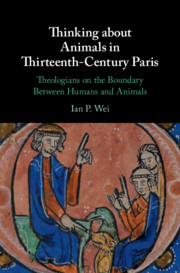 Thinking about Animals in Thirteenth-Century Paris
Thinking about Animals in Thirteenth-Century Paris Published online by Cambridge University Press: 07 August 2020
Chapter 2 explores how Franciscan theologians understood the similarities and differences between animals and humans. The Summa Halensis most frequently stressed clear difference and a strong boundary. Similarities were recognized, however, especially in relation to the corporeal. The Summa was not consistent in its approach to these similarities: sometimes they were simply natural features posing no moral or intellectual challenges, whereas on other occasions they were dangerously deceptive and symbolic of human sin. Bonaventure also accepted that in many respects the bodies of humans and animals were the same. Beyond this, however, he was not struck by much in the way of similarity. He took it for granted that humans were the most perfect animals, unique amongst animals in their possession of reason. Made in the image of God, humans related to God very differently from animals. Animals served humans, answering to their bodily and even emotional needs. Bearing symbolic meaning, they were God’s tools. Bonaventure did not see any of the similarities that underpinned more complex understandings in the work of others. For Bonaventure, the boundary between humans and animals was always clear-cut.
To save this book to your Kindle, first ensure [email protected] is added to your Approved Personal Document E-mail List under your Personal Document Settings on the Manage Your Content and Devices page of your Amazon account. Then enter the ‘name’ part of your Kindle email address below. Find out more about saving to your Kindle.
Note you can select to save to either the @free.kindle.com or @kindle.com variations. ‘@free.kindle.com’ emails are free but can only be saved to your device when it is connected to wi-fi. ‘@kindle.com’ emails can be delivered even when you are not connected to wi-fi, but note that service fees apply.
Find out more about the Kindle Personal Document Service.
To save content items to your account, please confirm that you agree to abide by our usage policies. If this is the first time you use this feature, you will be asked to authorise Cambridge Core to connect with your account. Find out more about saving content to Dropbox.
To save content items to your account, please confirm that you agree to abide by our usage policies. If this is the first time you use this feature, you will be asked to authorise Cambridge Core to connect with your account. Find out more about saving content to Google Drive.